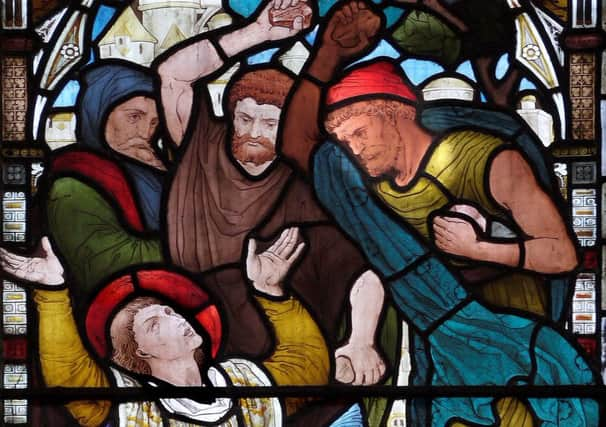The Civic Society column with David Winpenny


Christ the Consoler, Skelton-on-Ure, and St Mary the Virgin, Studley Royal, were built in the early 1870s – the former to commemorate the life of Frederick Vyner of Newby Hall, whose plight caused anxiety to Queen Victoria and whose untimely death was a national scandal, rocking the foreign policy of the government.
Frederick Vyner was the model of a nineteenth century Englishman. An elaborate memorial dedicated to his memory in the south choir aisle of York Minster says of him, ‘With the prospect of death ever before him, he thought of others, rather than of himself. He refused to purchase his own life by their peril and met his fate in the spirit of his own latest words – “We must trust to God that we may die bravely as Englishmen should die”.’


Advertisement
Hide AdAdvertisement
Hide AdVyner set out from Athens to visit Marathon on 11 April 1870. His eight-strong party included three ladies, among them Lady Muncaster from Ravenglass in Cumberland.
They had an escort of four mounted police, and twelve foot soldiers were to accompany them coming back, to protect them from the region’s bandits. On the return journey the carriages managed to get out of sight of the marching soldiers. In a thickly overgrown ravine, 20 armed brigands suddenly surrounded them and two of the policemen were shot.
The travellers were forced out of the carriages, taken into the mountains and interrogated. A ransom demand for 32,000 English sovereigns was sent to the Greek Government with Lady Muncaster and the two other ladies, who were accompanied by the two surviving policemen.
Meantime, Vyner and his friends were negotiating with the brigands. The demands were modified to either £25,000 – the equivalent today of around £ 1.25 million – or an amnesty. Lord Muncaster was sent after his wife with this second proposal. Vyner remained cheerful throughout, keeping up the spirits of his fellows. He refused to exchange places with the Swiss courier who was with them, even though it would have meant his own escape.


Advertisement
Hide AdAdvertisement
Hide AdGladstone’s government, in which Frederick’s brother-in-Law the Earl of Ripon was Lord President of the Council, had been pursuing a policy of detente with the Greeks. The brigands’ demands placed them in a very difficult situation. After much discussion and a flurry of diplomatic notes, the government replied that an amnesty was impossible under Greek law and asked the brigands to accept the ransom. The brigands now believed that the prisoners – as well as Vyner there were Edward Lloyd from the English Legation in Athens, Edward Herbert, an English barrister, and the Count Alberto de Boyl, a young Piedmontese nobleman – were relatives of Queen Victoria and worth vast sums.
Amid confused scenes, negotiations broke down.
Troops were sent to rescue the prisoners; they had been instructed not to shoot, but when they found the brigands some of them immediately opened fire. Alarmed into panic and surrounded by soldiers, the brigands killed their captives. Some of the kidnappers were captured, but most escaped.
There had been intense concern about the plight of the prisoners throughout England. Prayers were said for them in churches throughout the country. Queen Victoria followed the progress of negotiations with keen interest, perhaps more particularly because Frederick’s sister, Henrietta, Countess of Ripon, was a Lady of the Bedchamber to Alexandra, Princess of Wales.
When news came of the death of Vyner and his friends there was great sorrow.
Advertisement
Hide AdAdvertisement
Hide AdThe bodies of Frederick Vyner and Edward Herbert arrived back in England on 14 May 1870, and on the following day a special service was held at Westminster Abbey. In secular circles, too, the murders had their effect; the Spring Meeting of York Races was said to be ‘the quietest and saddest ever known’.
At Newby Hall, Vyner’s mother, Lady Mary, daughter of Earl de Grey, had been working tirelessly to raise the ransom. The money was put instead towards the building of the church of Christ the Consoler in the grounds of Newby Hall. Its designer, William Burges, was perhaps the most thoroughgoing medievalist of all the 19th-century Gothic Revival architects.
His work, full of colour and imagery, appealed to the Victorian romantics – especially those with money. He had designed the lavish interiors of Cardiff Castle for the Marquess of Bute; Frederick Vyner had been a friend of Bute’s at Oxford, and it may have been on the Marquess’s recommendation that Burges was appointed to build Skelton church and its sister building at Studley Royal.
Burges’s estimate for Skelton church was £10,000. By the time it was complete, in the autumn of 1876, it had cost the Vyners around £25,000 – exactly the sum raised for the murdered men’s ransom. The foundation stone was laid on Wednesday 17 May 1871.
Advertisement
Hide AdAdvertisement
Hide AdThe foundation stone of the church at Studley, which eventually cost £50,000, was put in place with full Masonic ceremony on Saturday 25 March. The Masonic involvement came about through the Earl of Ripon (he was elevated to be Ist Marquess of Ripon on 23 June that year), who was Grand Master of the Masonic Order in England from 1870 to 1875.
Lady Ripon, Frederick Vyner’s sister, was the main inspirer of Studley church – an early description says that it was ‘designed at a moment’s notice on the spot by Mr Burges, single-handed, the T-square and drawing board having been provided by Lady Ripon, so that the design might be made, as she said, by her architect and under her influence.’
These two local churches were not the only memorials Frederick Vyner and his murdered companions.
There are stained glass windows in the north choir aisle of Ripon Cathedral, in the chapel at Muncaster Castle in Cumbria to designs by Henry Holiday, at Gautby in Lincolnshire (another Vyner estate, where Frederick was buried) and, by William Morris’s firm, at Christ Church Cathedral in Oxford, where Vyner had been an undergraduate. There is also the memorial in York Minster. There can have been few young men of the nineteenth century so much mourned, and so well commemorated.